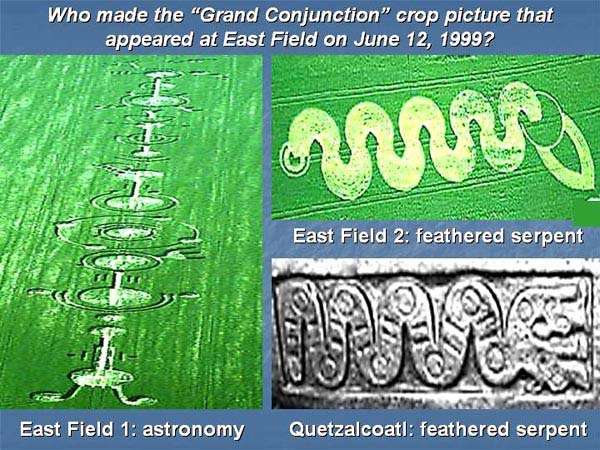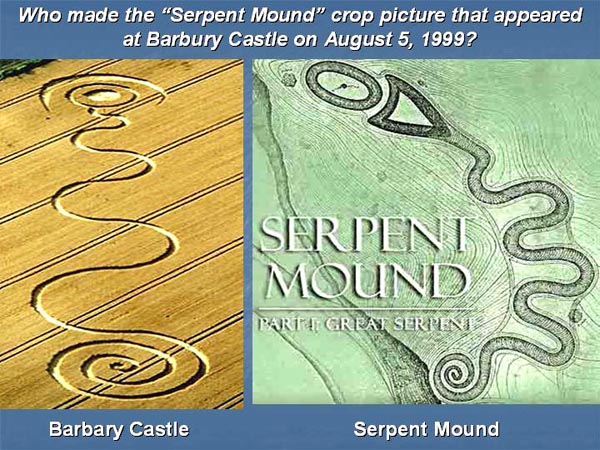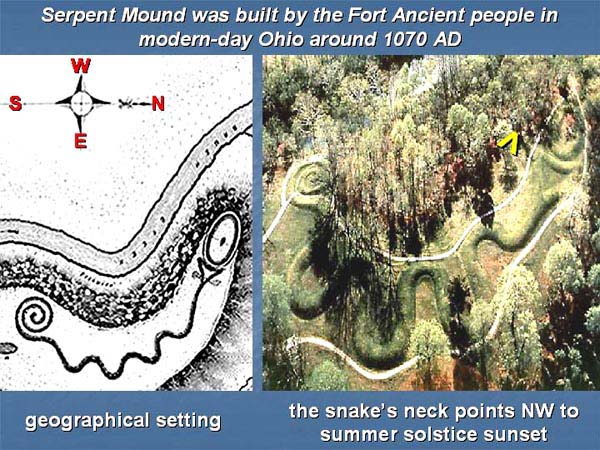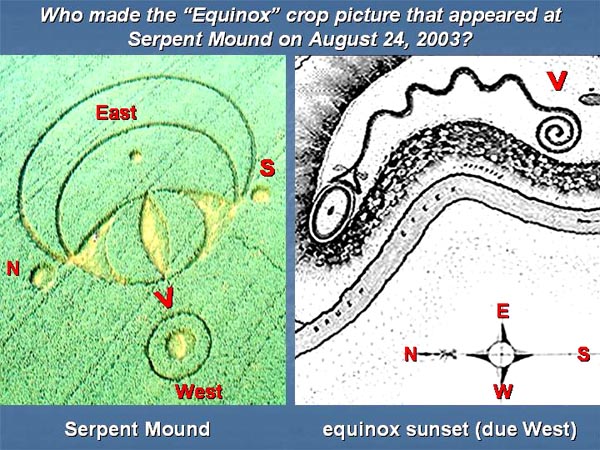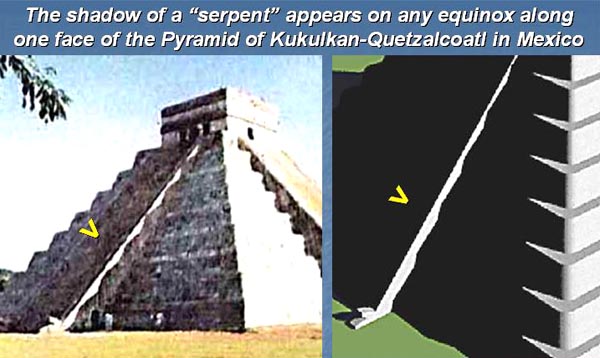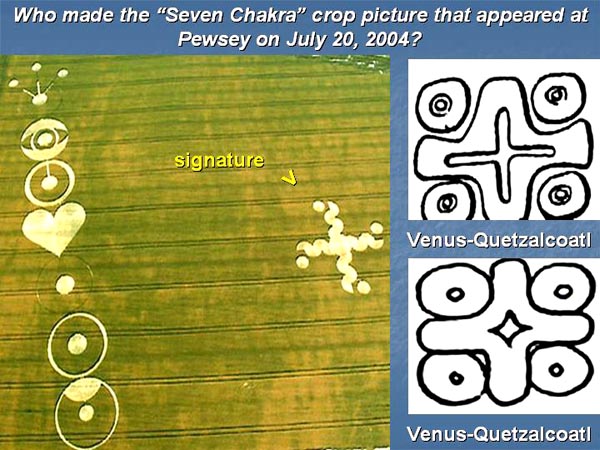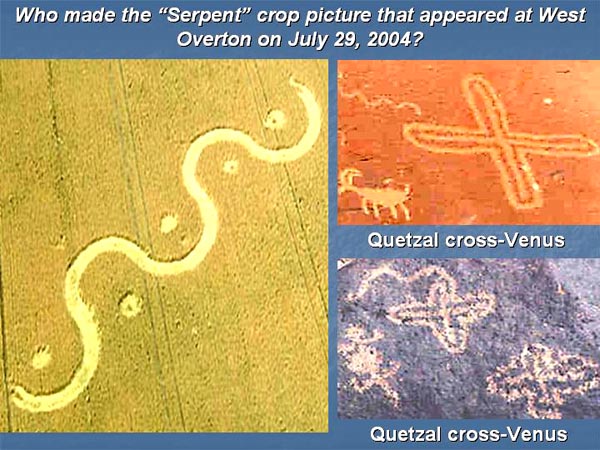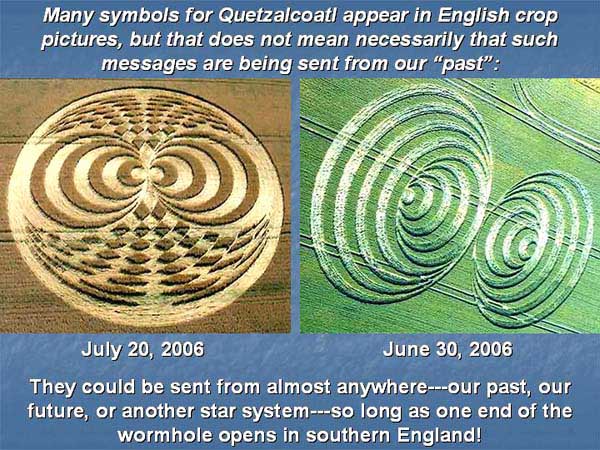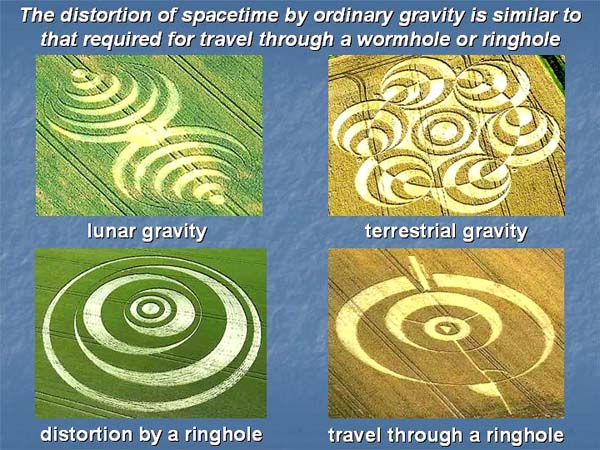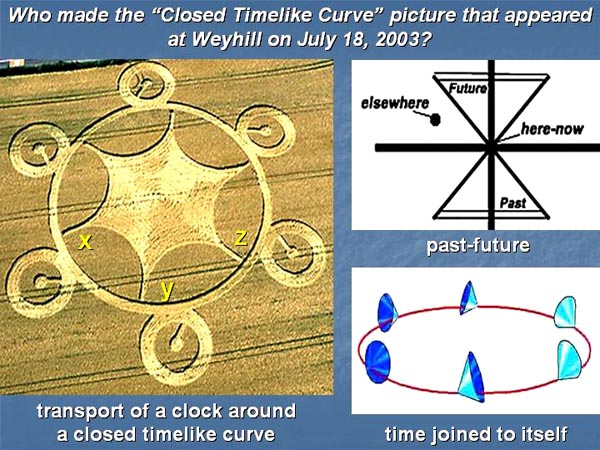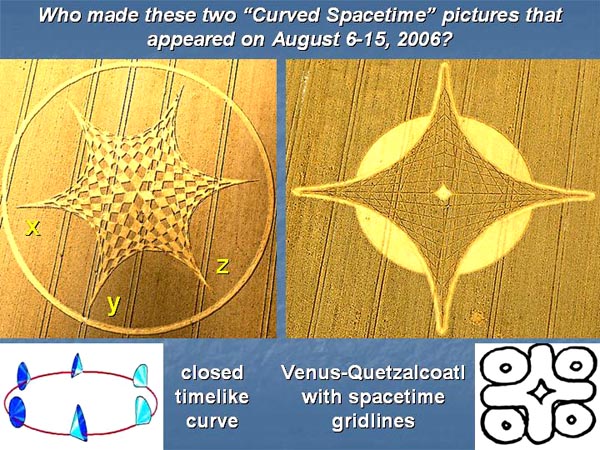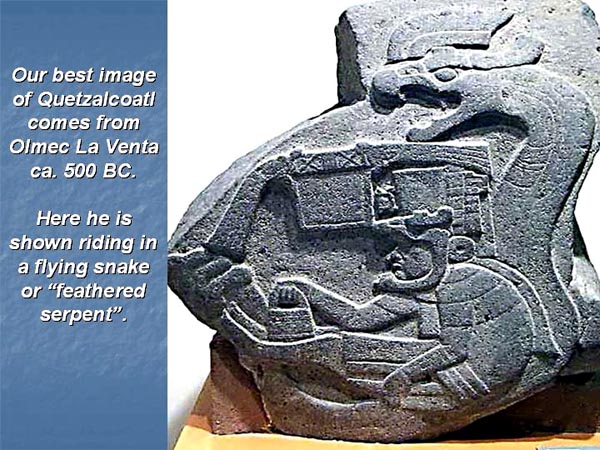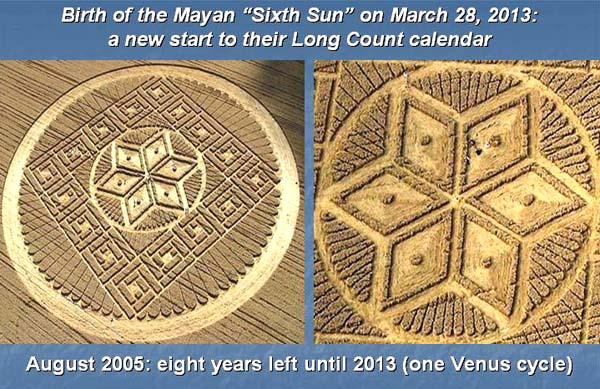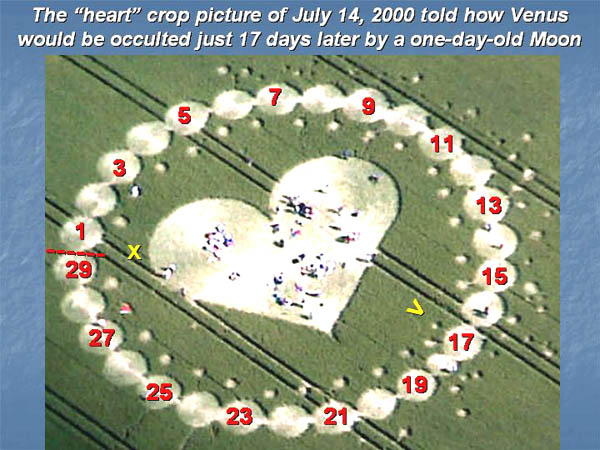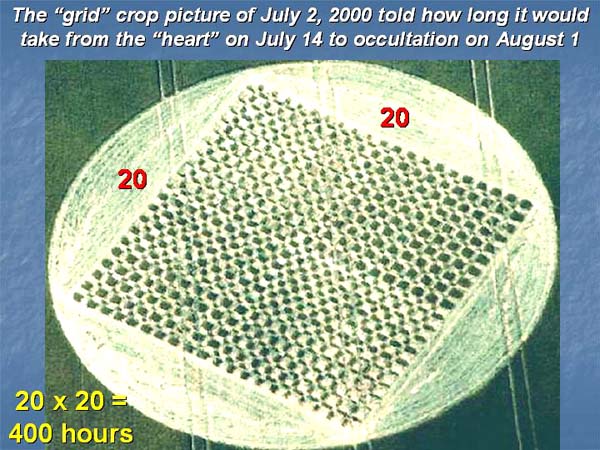|
Astronomy, spirituality and spacetime technology: more symbols for the legendary Quetzalcoatl in English crop pictures
Who makes modern crop
pictures? The major newspapers and TV tell you that
"they are made by people". Yet practically everyone who
has studied this particular subject for themselves, in
any kind of factual detail, knows that is not true: see
for example
www.cropcircleconnector.com/anasazi/time2007j.html
or www.lovely.clara.net/crophoax_debrief.html or www.ufoevidence.org/topics/CropCircles.htm or http://ourworld.compuserve.com/homepages/dp5/cropcirc1.htm.
In three previous
essays on this website, I found that those amazing and
complex field patterns often use an ancient Sun-Venus
calendar to count time in our modern era.
Furthermore, they sometimes show the symbols of a
legendary god-king known as "Quetzalcoatl-Kukulcan" to
the original natives of central America, or "Pahana-Awanyu"
to the native people of north America:
see www.cropcircleconnector.com/anasazi/time2007e.html or www.cropcircleconnector.com/anasazi/time2007d.html or www.cropcircleconnector.com/anasazi/time2007c.html.
What interesting clues!
Today we know about that ancient Sun-Venus calendar
mainly from the Dresden Codex, which was one of only
four native Mayan texts not burned by invading Spanish
priests: "The
Dresden Codex,
one of four surviving Mayan
chronicles, contains an extensive tabulation of the
appearances of Venus, and was used to predict the future."
(see
www.civilization.ca/civil/maya/mmc07eng.html).
Quetzalcoatl-Kukulkan
supposedly taught those central
American people all about astronomy, calendars,
mathematics, agriculture, building, human morality and
religion. In north America he was known to the Hopis as
Pahana or "lost white brother". Indeed, without some
kind of outside help, how could they have gotten so far?
"While Europe was still in the Dark
Ages, those
central American people mapped the heavens,
developed a
writing system,
and became
masters of mathematics. They also
invented some of
the calendars that
we still
use today." (see
www.mysteriousplaces.com/mayan/TourEntrance.html).
So what is going on
here? Who was Quetzalcoatl, and why should his
long-forgotten Sun-Venus calendar appear today in
English crop pictures, along with other symbols of his
once legendary presence? In order to address that
question, I made a careful survey of the CCC archives
from 1990 to 2007, and looked for any crop pictures that
might contain references to Quetzalcoatl under any of
his pseudonyms such as "feathered serpent", "Venus" or
"lost white brother".
Yet I have omitted from
discussion any "five pointed star" symbols for Venus,
which are fairly common in English crops: see for
example
Bythorn of September
3, 1993 on
www.lucypringle.co.uk/photos/1993/uk1993de.shtml.
The reason is that such five-pointed stars may refer to
the planet Venus itself, rather than to Quetzalcoatl,
who simply taught the ancient Olmecs and Mayans all
about Venus.
The "Grand
Conjunction" crop picture of June 12, 1999 was signed by
Quetzalcotal ("the feathered serpent") in a nearby field
There was a rare grand
conjunction of five planets, the Sun and the Moon on May
5, 2000 (see
http://terpsichore.stsci.edu/~summers/viz/may_5_2000/index.html).
Slightly less than one year earlier on June 12, 1999, a
spectacular crop picture of 700 feet in length appeared
at East Field, and described what would happen on
that day (see the left-hand side of the figure
below):
It showed a precise
linear alignment in the sky (as seen from Earth)
of five different planets plus the Sun and Moon, using a
unique type of astronomical symbolism that may have
been used by astronomer-priests in ancient cultures on
Earth (see
www.cropcircleconnector.com/anasazi/time2007f.html). Similar
symbols also appear in dumbbell-type petroglyphs from
north or central America, and mean there "motion of the
Sun or Moon" (see www.petroglyphs.us/photographs_atlatl_cliff_petroglyphs_AC.htm or
http://rupestreweb.tripod.com/motif.html). Finally, a
few parts of that long-forgotten astronomical
symbolism have come down to us today in terms of the
symbols used for aspects of the planets in
astrology: for example "conjunction", "opposition" or
"semi-square" (see
http://www.risingpisces.com/aspects.php).
So much for "Doug and
Dave", or
any other concept of human fakery! Some great astronomer
with a detailed knowledge of ancient science on Earth
had to have made that crop picture. But who? Well,
seemingly he told us directly, so that there would be no
mystery or mis-interpretation,
but most of us refused to listen. Thus in the nearby
field adjoining that spectacular 700-foot-long crop
picture, there appeared the image of a "feathered
serpent", which in Mayan or Aztec culture stands for
none other than the legendary Quetzalcoatl-Kukulkan
(see the right-hand side of the figure above,
or www.korncirkler.dk/cccorner/snake.html).
Another
crop picture from Barbury Castle on August 5, 1999
showed a schematic image of "Serpent Mound"
Two
months later at Barbury Castle on August 5, 1999,
another snake-like crop picture appeared (see the
left-hand side of the figure below):
In retrospect, one can
see that it was meant to represent some kind of
"feathered serpent", or more precisely the
detailed shape of a great earthwork called "Serpent
Mound" that was built by the Fort Ancient people in
north America around 1070 AD, in the vicinity of
modern-day Ohio (see the right-hand side of the figure
above). A more
detailed plan and aerial view of Serpent Mound
are shown below:
Modern archaeologists
believe that it was laid out with careful
respect to the four compass points North, South,
East, West, so that a "V' shape in the snake's neck
would point to sunset on the summer solstice (June 20)
at that particular
latitude:
see www.archaeology.org/9611/newsbriefs/serpentmound.html.
Yet another crop
picture from Serpent Mound on August 24, 2003 showed the
location of sunset on any equinox
Somewhat surprisingly,
Serpent Mound in Ohio was also the location of a rare
American crop picture on August 24, 2003:
That crop picture
seemed to show the four compass points N, S, E,
W, as
well as a "pointer" that pointed due West toward sunset
on either equinox (spring or fall). It was aligned
geographically (see the large red arrow) in a field
direction of due West,
past the "snake's tail" (see
http://members.fortunecity.com/lt1000/serpent_cc.htm).
The Pyramid
of Kukulcan (Quetzalcoatl) in Chichen Itza shows the
shadow of a "serpent" on any equinox
Much further south in
modern Mexico, one can again see a huge serpent shape on
any equinox! Thus, the shadow of a "slithering serpent"
descends from the sky to the ground along one face of
the Pyramid of Kukulkan (Quetzalcoatl) at Chichen Itza,
twice each year on the spring and autumn equinoxes:
"For over
a thousand years, the rays of the setting sun
have cast a
spectacular shadow on
this great Mayan pyramid. During each
of two yearly
equinoxes,
the shadow of the Feathered Serpent Kukulcan or
Quetzalcoatl appears on the northern stairway,
and then
vanishes."
(see
www.world-mysteries.com/chichenitza_sn.htm or
www.youtube.com/watch?v=vQsqpG0XN0g).
Both Serpent Mound in
modern-day Ohio, and the Pyramid of Kukulcan in
modern-day Mexico, represent clear and unambiguous
evidence that there once lived a teacher-god called
Quetzalcotal-Kukulkan in those regions, whose symbol was
a "feathered serpent".
A "Seven Chakra"
crop picture on
July 20, 2004 was signed by Quetzalcoatl ("Venus")
in the same field
Now back to modern
England. Have there been any more crop pictures that
show Quetzalcotal-type motifs, other than the two
mentioned above? Yes indeed! For example at Pewsey on
July 20, 2004, we saw an amazing "Seven Chakra" picture
which depicted the seven different chakras or spiritual
centres of the human body, from "crown" down to "third
eye, throat, heart, solar plexus, spleen or root":
Those seven
chakras have been recognized in many cultures on Earth,
since the very beginnings of civilization
here (see for example
http://rickrichards.com/chakras/Chakras1a.html
or
www.healingarticles.info).
Yet they are generally
denied by contemporary Western science, because the
concept postulates an organized form of life
energy known as "spirit" that most Western
scientists do not accept.
Nevertheless, sometimes
we need to listen to those more knowledgeable
than ourselves!
Thus, not far away in the same field from where that
"Seven Chakra" picture was drawn, there appeared on the
same day yet another kind of symbol for the legendary
Quetzalcoatl: this time in
the shape of a "four-armed
cross" (see the figure above, right-hand side).
That was how the
Mayans and Aztecs symbolized planet Venus. And
since Quetzalcoatl
taught them all about
the astronomy of Venus, as well as their 52-year
Sun-Venus calendar, they often equated Venus with the
great teacher himself. The "wiggly" nature of each
of its four arms adds the connotation of "serpent", as a
nice artistic touch.
A "Serpent" crop
picture on July
29, 2004 showed symbols for Quetzalcoatl
("Venus-serpent") from north American petro glyphs
Only one week later on
July 29, 2004, yet another serpent-type crop picture
appeared at West Overton:
Its serpent-like shape
matches closely several rock art inscriptions or petro
glyphs made in southwest America 1000 to 2000 years ago
(right-hand side of the figure above). Those particular
petro glyphs are known to modern archaeologists as
"Quetzal crosses", because they show two different
symbols for Quetzalcoatl ("serpent" and "Venus") in close
proximity to one another.
Only three days later
on August 2, 2004 at Silbury Hill, a now famous "Mayan
Sunstone" crop picture appeared and made worldwide news
(see http://news.bbc.co.uk/1/hi/england/wiltshire/3552168.stm). Originally there was some controversy, because its indicated calendar end-date of (2004.6 + 8.67) = 2013.3 or late March 2013 did not agree with another expected end-date of December 21, 2012 for an end to the Mayan Long Count calendar. But on further study, it became clear that the Mayans and Aztecs kept two different calendars.
One calendar would end
on December 21, 2012 (their "Long Count"), while the
other calendar would end on March 28, 2013 as shown at
Silbury Hill (their Sun-Venus calendar). None of the
supposed human fakers would have had the faintest idea
about that second, obscure Mayan calendar. Furthermore,
the same long-forgotten Sun-Venus calendar has
been shown in many other crop pictures over the past ten
years
(see www.cropcircleconnector.com/anasazi/time2007c.html). Who else could possibly teach us all of these things, except for Quetzalcoatl and his colleagues?
The Hopi legend
of Pahana or "Lost White Brother"
When he and his
colleagues lived and taught on Earth many thousands of
years ago (almost like an interstellar "Peace Corps"),
Quetzalcoatl-Kukulkan seemingly taught not only in
central America to the Olmecs or Mayans, but also in
north America to many native tribes there such as the
Pueblo, Anasazi or Fort Ancient. To them he was known as
"Pahana" or "Awanyu". The Hopi people in particular
kept detailed oral histories about him, including what
would happen someday when he returned:
"Pahana is the Lost
White Brother of the Hopi. Most legends have it that
Pahana left for the east at a time when the Hopi entered
the Fourth World and began their migrations. However,
the Hopi say that he will return again; and at his
coming the wicked will be destroyed, and a new age of
peace will be ushered in. Their legend of the Pahana
seems intimately connected with the Aztec story of
Quetzalcoatl from central America. Such
similarity is furthered by the common
representation of Pahana-Awanyu in Hopi or Pueblo art as
a horned or plumed serpent. Those figures
bear a striking resemblance to images of Quetzalcoatl
the feathered serpent in
Mexico." (see
http://en.wikipedia.org/wiki/Hopi_mythology).
"My people await Pahana, the lost White Brother from the stars, as do all of our brothers in the land. He will not be like the white men we know now, who are cruel and greedy. We were told of their coming long ago. But still we await Pahana."---White Feather of the Hopi,1960 (see www.loveforlife.com.au/node/2308). Several remarkable crop pictures suggest that those crop artists are capable of time travel Are these crop images being sent to us from the distant past, by the historical Quetzalcoatl or his colleagues? Possibly, but we cannot know for sure. Another possibility is that those crop artists have some kind of messaging capability through space or time, which uses in physics what is known as as a "wormhole" or "closed time-like curve". "As time is incorporated into the structure of space-time, the theory of general relativity becomes filled with closed time-like curves. A closed time-like curve allows for time travel, in the sense that any observer who travels on a trajectory through space-time along such a curve will return to some event that coincides with his departure." (see F. Lobo and P. Crawford, NATO Science. Series II 95, 289-296, 2003). Thus, some of those crop artists may have lived on Earth
in the distant past: say in the Avebury region of England,
central America or
Germany, but that does not mean they are located there
"now". A more precise way of describing this situation would
be to say that they are still "connected" to our present
time and space by means of a space-time wormhole
or "conduit", as described
at Crabwood in 2002
One end of that conduit might open regularly in southern England, 50 times every summer, so as to create new crop pictures, but we can't be sure where the other end is located. In our past? In our future? Somewhere else in the solar system? Around a distant star? Or in another universe entirely? Once any crop picture is made, then the wormhole closes and we see nothing. That is why at Crabwood 2002 they said "conduit closing" to end their message (see www.cropcircleresearch.com/articles/alienface.html). Does everyone understand now? Other phrases such as "much pain but still time" or "believe: there is good out there" also indicate some type of space-time messaging. Actual photographs of a micro-wormhole opening and closing, in the vicinity of a newly made crop picture, were shown by filmmaker Terje Toftenes in a seminar last summer (see also his DVD "Crossovers from another dimension" as cited on http://thecropcirclewebsite.50megs.com/page22.htm or http://video.barnesandnoble.com/search/product.asp?ean=185483906534). Most academic scientists from the 18th century refused to believe in meteorites (has anything changed?) Most modern physicists refuse to even look at these strange but important data, in the same way that other academics from the past refused to look through Galileo's small telescope, or refused to believe that "rocks could fall from the sky". "The idea that stones can fall out of the sky was scornfully denounced by the Académie Française as an unscientific absurdity. Antoine Lavoisier told his fellow Academicians, 'Stones cannot fall from the sky, because there are no stones in the sky!' The concept of meteorites was thus condemned as nothing but medieval illusions and old wives' tales. Embarrassed museums all over Europe hurriedly threw out their cherished meteorite collections, as humiliating anachronisms from a superstitious past. Farmers who came to the Académie with samples of meteorites were laughingly shown to the door, and denounced as superstitious peasants. On the night of April 26, 1803 however, perceptions began to change. On that night the people of L'Aigle were awoken by the thunderous noise of more than 2000 rocks falling from the sky. That undeniable display woke up the Académie, who were finally compelled to take notice." (see www.mysteriousnewzealand.com/featurearticles/featart_meteorites.html). The distortion of spacet-ime by ordinary gravity is similar to that required for travel through a wormhole or ring-hole A few modern physicists have studied space-time wormholes or ring-holes in a theoretical sense (see for example www.math.siu.edu/Kocik/tm/tm-all-ch.htm), but how could anyone create a space-time wormhole or time-travel device in a practical sense? Those crop artists, by means of a series of pictures over the years, have shown us in principle how it might be done. In the first two pictures below (upper left and right), they portray lunar gravity (two lunar crescents) or terrestrial gravity (Earth in orbit about the Sun) as two related aspects of "weakly curved space-time":
Then in another two pictures below (lower left and right), they portray space-time wormholes or ring-holes as a property of "strongly curved space-time". There the degree of distortion has become so great, that it creates a tiny hole or tunnel ("conduit") in the fabric of space-time, which some crop-artist device or ship can cleverly travel through. (The "ring-hole" is just a stable kind of wormhole.) Isaac Newton wrote in his Appendix to Principia in 1713: "I have not as yet been able to discover the reason for these properties of gravity, and do not feign hypotheses." Would anyone have really expected Newton in 1713 to envisage the four-dimensional curvature of space-time, as a possible cause of gravity? That idea had to wait for another two hundred years to be proposed by Einstein in 1916. Seventy years later, Kip Thorne in 1985 legitimized the concept of a "transversible space-time wormhole" (see http://library.thinkquest.org/27930/wormhole.htm or www.its.caltech.edu/~kip/scripts/publications.html). The technological reality of such a fantastic concept has now seemingly been realized, not in a physics laboratory somewhere, but in English fields. Many Wiltshire farmers seem able to recognize such things (just like French farmers who took meteorite samples to the Académie in 1790), but contemporary physicists refuse to study the evidence in any form whatsoever. Come on, guys, when did you start relying on newspaper or TV reports for experimental fact? Where is your innate curiosity or investigative instinct? "Closed time-like curves" also appear in English crop pictures Not only wormholes or ring-holes (as discussed above) have appeared in English crop pictures, but also loops through time or "closed time-like curves". The closed time-like curve or CTC is a very sophisticated physical concept that no human faker could possibly be expected to envisage (see http://everything2.com/index.pl?node_id=811453). Thus, one closed time-like curve was shown in crops at Weyhill on July 18, 2003:
On the left above, one can see how "transport of a clock" around three-dimensional space xyz along the path of a closed time like curve may be accompanied by no change of time whatsoever. On the right above, one can see how a certain kind of "light cone" describes our past, future, here-now and elsewhere. When a series of such light cones are joined into shape of a closed time like curve, we see that time "joins back onto itself". Another closed time like curve was shown at Blowingstone on August 6, 2007. See the left-hand side of the figure below:
Then one week later at Etchilhampton Hill on August 15, 2007, we saw a typical Venus-Quetzalcoatl symbol from Mayan-Aztec culture, but now with curved space time gridlines superimposed (see the right-hand side of the figure above). Its implied symbolism seems clear: not only does Quetzalcoatl as a crop artist wish to be associated with "Venus" and "feathered serpent" motifs, but also with the "curvature of space time". Spacetime wormholes and "balls of light" on a Utah ranch Ten years ago, it became apparent that wormholes and "balls of light" were also being observed at a remote rural location in Utah. Hence a Las Vegas businessman, Robert Bigelow (see http://en.wikipedia.org/wiki/Bigelow_Aerospace), purchased that ranch and set a scientific team to work on it. One of the investigators was Colm Kelleher, who has a Ph.D. in molecular biology (see www.huntfortheskinwalker.com). Although no firm conclusions were reached, a large number of witnesses saw unusual phenomena there, including "orange wormholes" and "balls of light" of many different kinds. Some people believe that "balls of light" may be responsible for creating modern crop pictures (see www.cropcircleresearch.com/articles/e010-merkaba.html or http://www.medwaycropcircle.co.uk). Could such "balls of light" be small, remotely controlled devices that those crop artists use to send us messages from a great distance? Yet similar lights have also been seen in Utah, where there are no crop pictures. So perhaps those "balls of light" are just an indirect consequence of nearby wormhole activity? East Field of July 7, 2007, for example, was seemingly created by a large flash of structured energy that resembled "sheet lightning": "It was filmed while
forming by five separate cameras, including infrared CCTV,
in the presence of three witnesses. To the naked eye,
observers saw only a white flash similar to sheet lightning
at 3:13 AM. But the ultralow-light CCTV camera saw
considerably more. Viewing that light-enhanced video over
the following seven minutes, a large 300-meter-long crop
picture seemed to develop right in front of the camera."
Are closed time-like curves and wormholes or ring-holes consistent with modern physics? Now let us get down to the nitty-gritty. If (a) time travel were really possible, and (b) certain space-time travellers visited Earth in the distant past, so as to stimulate or encourage our early civilization here, then the current crop-circle mystery would be solved. What does modern physics have to say about all of this? The famous cosmologist Stephen Hawking seems to agree (a) that time travel is possible, yet argues also (b) that we don't see time travellers or "tourists from the future" in central London today! Partly for that reason, he proposed in 1992 a rather ad hoc physical postulate known as the "chronology protection conjecture" which goes as follows:
"It has been suggested that an advanced civilization
might have the technology to warp space-time, so that
closed time-like curves would appear, thereby allowing
travel into the past. This paper examines that
possibility. The results support a chronology protection
conjecture,
where the laws of physics do not allow for closed
time-like curves." (from Physical Review D46,
603-611, 1992).
But later in 2003, another cosmologist Pedro Gonzales-Diaz (inventor of the "ring-hole" concept) wrote: "It is now generally recognized that the chronology protection conjecture was just a semi-classical proposal, with no implementation in any kind of space-time with quantum structure. It would follow therefore that closed time-like curves and time travel are both stable quantum mechanically, and pervade the entire space-time structure of the vacuum." (from Physical Review D68, 084016, 2003). In summary, there seems to be no objection from modern 21st-century physics concerning the twin concepts of "closed time-like curves" or "time travel", at least on a quantum scale. Both are considered possible, although technologically beyond our current grasp. By analogy, could classical Greeks or Romans manufacture a mobile phone? But genetically and intellectually, they were just like us. Who was Quetzalcoatl really? With those rather difficult ideas in mind, let us now return to the vexing question of Quetzalcoatl. Who was he really? Could he have been a time-traveller from our own future on Earth, or maybe from a distant star system where other humans also live? Our most reliable image of Quetzalcoatl comes from a detailed stone sculpture that dates back to Olmec La Venta around 500 BC:
Most current archaeologists have interpreted that remarkable piece of sculpture to represent a "corn god". Really? When studied objectively, do not many of its images seem a bit too modern for the central American jungle, 2500 years ago? He is shown there riding inside of some "flying snake". Could that be the origin of his symbol "feathered serpent"? One cannot be sure from limited archaeological evidence, in combination with ancient legends, who Quetzalcoatl really was; but the native people of central, south and north America once reverenced him as a "beloved god-king" who taught them everything they knew, and made their lives much better than before. Furthermore, everything he taught (e.g. mathematics, astronomy, or the Sun-Venus calendar) was far ahead of its time, and quite anomalous for a historical epoch when Europe was still without technology, or even in the Dark Ages. Will Quetzalcoatl return in the next calendar year "One Reed" as 2039 AD? The modern crop-circle phenomenon began in earnest in the late 1980's, especially in the summer of 1990 in Wiltshire. Many people believe that it may be headed for some kind of climax fairly soon, just five years from now in late 2012 or early 2013. How do those modern calendar dates compare with ancient central American legends that prophecy the "return" of Quetzalcoatl? "Cortés learned that he was considered by the Aztecs to be either an emissary of Quetzalcoatl, or Quetzalcoatl himself. Quetzalcoatl was a legendary god-king who according to prophecy would return in some year 'One Reed'. The Mayan-Aztec calendar was divided into 52-year periods that represented half-astronomical cycles of Venus. Every 52nd year was called 'One Reed'. By chance, Cortés arrived in a year 1519 that was also One-Reed." (see http://en.wikipedia.org/wiki/Spanish_conquest_of_the_Aztec_Empire). A native historian later wrote (Ixtlilxochitl, 1600): "Quetzalcoatl said that in a year 'One Reed' he would return, and then his doctrine would be received, and his children would possess the land." When will the next year "One Reed" occur in our modern calendar? From 1519 to 1987, one can count 468 = 9 x 52 years. The last year "One Reed" by that reckoning would therefore be 1987 AD, while the next will be 2039 AD. Hence neither an upcoming end to the Mayan Long Count calendar on December 21, 2012, nor an end to their Sun-Venus calendar on March 28, 2013, may necessarily be "One Reed". Another possible date of return as 2013 AD But another legend suggests: "I will return after five full cycles of the dawn star (Venus), bringing a reign of peace, and the advent of a new spiritual order " (see www.wolflodge.org/sananda/chilam-1/way_of_the_jaguar.htm). Indeed, five full cycles of Venus were shown at Chute Causeway on July 26, 2007 (see www.cropcircleconnector.com/2007/chute/chute2007.html). Why make a crop picture of that kind, except to remind us of the ancient prophecy? Likewise, the famous "Mayan Sunstone" picture that appeared at Silbury Hill on August 2, 2004 implied that we had just (52 / 6) = 8.67 years left, until our current Sun-Venus calendar would end in early 2013. By simple arithmetic, its date of formation as August 2, 2004 (or 2004.58) plus 8.67 years equals 2013.25. That yields approximately March 28, 2013, when Venus will enter into superior conjunction with the Sun. Could modern crop pictures be associated with time travel, or with a carefully engineered change in Earth history?Could all of these modern crop pictures be portents of Quetzalcoatl's return, in early 2013 or maybe 26 years later in 2039? If so, why should they appear near Avebury in southern England, rather than in central America where Quetzalcoatl once taught? We have no definite answers yet to those important questions, but something is surely afoot. Indeed, by showing us pictures that seem to have been transmitted through some kind of "conduit" or closed time-like curve, from another space or time to modern humans here on Earth, are those crop artists trying to change our current historical timeline? From one that leads to destruction ("much pain but still time") to another that leads to peace ("believe: there is good out there")? "One feature of a closed time-like curve is that it opens the possibility of a historical timeline that is not fully connected to earlier times. Ordinarily, the principle of causality requires that each event in space-time be preceded by its cause. Yet in the presence of a closed time-like curve, causality may break down." (see http://en.wikipedia.org/wiki/Closed_timelike_curve). Well, we should learn soon! It would therefore be a good time now for all humans on Earth who would actually like to see Quetzalcoatl return---not the cruel and greedy ones, but all of the others---to pay attention to any new crop messages that may appear in the summers of 2008, 2009, 2010, etc., and think carefully about what those messages mean. Red Collie Appendix 1. Teaching us their Sun-Venus calendar in the summer of 2007 (or Long Count calendar in 2005) When studied in retrospect, it seems that ten different crop pictures from the summer of 2007 were designed to teach us about their 52-year Sun-Venus calendar. That is the calendar which Quetzalcoatl-Kukulkan taught to the Olmecs and Mayans in central America thousands of years ago. Today we know about it mainly from historical records such as the Dresden Codex (see www.astronomy.pomona.edu/archeo/dresden/dresden-tour.html). Table
1. Venus-related crop pictures from the summer of 2007
Why so much emphasis on teaching their Sun-Venus calendar in the summer of 2007? There could be two possible reasons for this: (a) to provide more evidence linking modern crop pictures to the ancient legend of Quetzalcoatl, or (b) because Wayland's Smithy from August of 2005 was coded using the same 52-year Sun-Venus calendar.
Indeed, it was not
until more crop information was given in mid-August 2007,
that we finally decoded Wayland's Smithy correctly.
It thereby provided a precise future-predictive date of
November 20, 2007 for when Comet 17P Holmes would conjunct
with a bright star Mirfak in Perseus (see
www.cropcircleconnector.com/2007/stanton/stanton2007.html
This is not the first time that we have been taught in crops about ancient Mayan calendars. For example, one week after Wayland's Smithy on August 9, 2005, there appeared another spectacular Mayan crop picture on August 15 at Woolstone Hill. The latter was apparently meant to teach us about their Long Count calendar, which lasts for 5125 years from August 13, 3114 BC to December 21, 2012 AD.
Each period of 5000 or so years in any Long Count is known as a "Sun". Currently we are living in the Fifth Sun, because four other 5000-year epochs or Suns were recorded in the distant past, in addition to our own. But early in 2013 we will enter into the Sixth Sun, which may be an era of great joy and exuberance:
The sixteen "boxes" which surround that Sixth Sun (above left) refer to a crop picture from Wayland's Smithy in the previous week. There our current 52-year Sun-Venus calendar was divided into 16 parts of 3.25 years each. That 52-year calendar will end on March 28, 2013, which is presumably when the Sixth Sun will begin. Why was Woolstone Hill drawn in August of 2005, and not in some other year? Well, on that particular date, there were just eight years left until March 2013, as one complete 8-year cycle of Venus.
An even earlier example of the Mayan Long Count was shown in crops from 2001. It was discussed by Geoff Stray in terms of an 18-month yearly calendar of 360 days, where each month contains 20 days: see www.swirlednews.com/article.asp?artID=110. Yet another example of the Mayan Long Count was shown in crops from 2006. There it was provided with some possible astronomical significance, in terms of long-term periodic emissions from our galactic centre: see www.cropcircleconnector.com/anasazi/waylandsmithy2007a.html. Appendix 2. The "heart" crop picture of July
14, 2000 described an eclipse
or occultation of Venus by the Moon on August 1, 2000
( Those 29 large
circles could plausibly
represent the Moon, since there are 29.5
days in any lunar phase cycle. But
how might planet Venus relate astronomically to the Moon,
back in the summer of 2000? Well, only 17 days after
that "heart" picture appeared, the Moon eclipsed or "occulted"
Venus on August 1, 2000. On the other side of that
same crop picture, another
small circle from
the inner ring shows
a slight downward
dislocation (yellow arrow,
centre right) just after day 15 of any
29-day lunar phase
cycle. That additional
feature was meant to tell us how
many days any new
Moon will remain
visible above the horizon, while it grows from "new" to
"full" (when seen at sunset, also shown at Stonehenge
in 1996). Many other small,
irregularly-spaced circles,
located outside
of that 29-circle outer
ring, presumably represent background stars.
If we interpret each of those squares as "one hour", then there should be 400 hours or (400 / 24) = 17 days from appearance of the "heart" on July 14, to when the Moon occults Venus on August 1. Is that true? Yes, again it seems precisely correct! Who else but Quetzalcoatl, the great master of Venusian calendars and astronomy? Indeed, on the very next
day (July 16) after both "grid" and "heart" pictures were
laid down in English crops, there appeared at Avebury Down
the characteristic image of a "three lobed jester's hat",
which was a symbol of Quetzalcoatl among Mayan kings for
over a thousand years (see
www.cropcircleconnector.com/anasazi/time2007e.html
or
www.mesoweb.com/pari/publications/RT08/JesterGod.pdf,
"Iconographic Heritage of the Mayan Jester
God", Virginia Fields, Los Angeles County Museum of
Art). Once again, the legendary Quetzalcoatl seems to have
"signed" his artwork! One possibly valid criticism has been directed to me by other professional scientists, that we in the crop-circle research community are not following their chosen if hypothetical "scientific method". According to such critics, true science consists of the following: (i) formulating some new mathematical formula, then (ii) testing that formula against new experimental results of increased accuracy, in order to learn whether it might be better than other formulae from the past? Particle physicists do this quite regularly: see for example www.g-2.bnl.gov where it says: "The muon (g-2) experiment at Brookhaven National Laboratory is stringently testing the Standard Model of particle physics, by measuring the anomalous magnetic moment of the muon to unprecedented precision." That interesting criticism might hold true, if modern science were carried out in such a fashion all across the globe. Yet in fact, their particular definition of science only holds true for a relatively narrow range of human endeavours. In other words, it is a small subset of the whole field, and not the field itself. Thus, the vast majority of scientific research as done today consists largely of "random fact gathering", in the hope that "some pattern will emerge": see for example neurobiology, developmental biology, genomics, cancer research, nanotechnology, or other novel fields of enquiry that were begun only recently. Chemistry lies halfway between physics and biology: with some valid theories, but still much left unknown, especially in medically important areas such as drug design. Now in regard to crop circle research, it seems obvious that no one could possibly determine in advance, by any precise mathematical formula, what kinds of new crop picture will appear in the summers of 2008, 2009 or 2010. All we can do is make educated guesses by means of careful logical study, while trying to avoid wild speculations. As another difficulty, some crop pictures actually seem to "predict the future" (say for comets 17P Holmes or 73P Schwassman-Wachmann 3). How could any human of ordinary intelligence possibly be expected to interpret those, except partly beforehand, and partly in retrospect? By analogy, if we were receiving SETI messages from some distant star by means of radio waves, would current astronomers refuse to study those messages, simply because new ones could not be predicted theoretically in advance? Of course not: the very idea seems ludicrous! True science therefore consists mainly of a "study of nature". We have to work from whatever we have been given, and will continue to do so, no matter what the armchair philosophers say. RED COLLIE |
